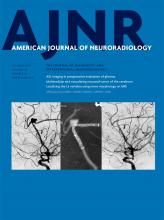In medicine, it is a common reaction for referring physicians to ask for the less expensive imaging technique if the a priori suspicion of finding abnormalities is low. For example, in a case with a mild traumatic brain injury (MTBI) and low suspicion of finding trauma-related brain abnormalities, the referring physician oftentimes asks for the cheaper, yet less sensitive, CT rather than the more expensive, but also more sensitive, MR imaging to detect, for example, diffuse axonal injuries.1 This reaction is intuitively understandable, notably in times of increasing economic pressure.
However, when considering the situation in more depth, this reaction might be questionable. If a test with a low sensitivity is performed in the setting of a low clinical suspicion (ie, a low pretest probability), this will result in a high proportion of false-negative cases.
From the perspective of optimal patient care, a test with a low sensitivity in the setting of a low pretest probability is not suited to rule out pathology because of the high likelihood of false-negative results.
From the perspective of cost effectiveness, the less expensive yet less sensitive test will result in a high proportion of false-negative examinations. Consequently, many imaging tests must be performed to have 1 positive imaging finding. The accumulated cost for 1 positive imaging test might therefore be high despite the relative low cost of each individual imaging test. In contrast, a more expensive yet more sensitive imaging test will have fewer false-negative cases; consequently, fewer cases are needed to have 1 positive imaging finding. The resulting accumulating cost for 1 positive test might therefore be lower compared with a less expensive yet less sensitive test. This concept might be called “number needed to image” (NNI [ie, the number of imaging examinations needed to have 1 positive imaging test]).
Moreover, there are additional indirect costs that should be considered. A more expensive and more sensitive test might avoid repeated false-negative imaging and repetitive medical consultations for the patient. The earlier and more specific diagnosis might allow for earlier treatment and, consequently, faster and earlier recovery.
In fact, to have a cost-effective imaging assessment, physicians should ask for the less expensive and less sensitive imaging test in the setting of a high clinical suspicion of abnormal findings. In this setting, the less sensitive test might be very cost-efficient and, at the same time, will result in only a low rate of false-negative imaging results.
In medicine, the equivalent concept of number needed to treat (NNT) is well established.2,3 Physicians treat patients (eg, with antiaggregation or antihypertensive medication to prevent stroke) knowing that only 1 of n patients will actually benefit from the treatment. For example, in patients with relatively nonsevere hypertension (diastolic blood pressure, 90–110 mm Hg), the NNT to prevent 1 stroke is 118, whereas this number is 29 in patients with more severe hypertension (diastolic blood pressure >115 mm Hg).4 This creates not only a cost related to the medication, which is oftentimes prescribed for years or even decades, but also medication-related side effects.
Concerning imaging, the corresponding concept of NNI is not yet well established. If, in the current example of MTBI, only 1 of 29 MR imagings would demonstrate subtle posttraumatic findings not visible on CT, this would probably generally be considered as too expensive to justify imaging, though MR imaging has no relevant side effects in contrast to the medical treatment discussed above. Moreover, considering the additional effect on associated costs, such as medicolegal and insurance-related costs, imaging would probably still be highly cost-efficient even if a substantial number of cases have negative MR imaging results.
This principle of NNI applies not only to MTBI. Other examples might be cervical spine radiography instead of CT or MR imaging for low impact cervical spine trauma, or wrist radiography instead of CT or MR imaging for low suspicion of scaphoid fracture, etc.
In conclusion, it is an intuitively understandable reaction to ask for a less expensive and less sensitive imaging test in the setting of a low clinical suspicion of finding abnormalities. However, this intuitive reaction might be neither suitable to reliably rule out pathology nor cost-efficient. The concept of NNI should be further developed to define how many negative imaging tests can be allowed for 1 positive finding, both from the perspective of optimal patient care as well as from the perspective of cost-effective imaging.
- © 2017 by American Journal of Neuroradiology







